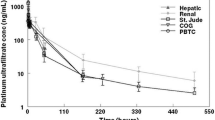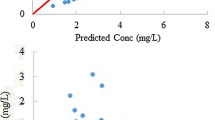Abstract
The objective of this study was to explore correlations between a variety of covariates and oxaliplatin ultrafilterable and blood pharmacokinetic parameters. Data from 40 patients receiving oxaliplatin combined with 5-fluorouracil and levofolinic acid as standard treatment for advanced colorectal cancer were analysed. Plasma ultrafilterable, blood, and urine platinum concentrations were determined by flameless atomic absorption spectrophotometry. Data were analysed according to a population pharmacokinetic method using the NONMEM program. The best fit for oxaliplatin plasma ultrafilterable clearance (CL) was given by the following equation, which considers four covariates: body surface area (BSA, in metres squared), age (in years), sex (0 if male, 1 if female), and serum creatinine (Scr, in micromoles per liter): CL (l/h)=5.49xBSA+4.55xBSAx(140–AGE)x(1–0.15xSEX)/Scr. By taking into account these covariates, the interindividual variability in CL decreased from 43% to 33%. Renal clearance represented 34% of the overall elimination. This value was obtained by recovering urine over only 5 h from the beginning of the infusion and modelling the data using NONMEM. We would recommend the use of this methodology for pharmacokinetic studies in oncology in which renal clearances of the drug are presently rarely explored. The oxaliplatin blood concentrations versus time observed during the three-cycle period were well-described by a three-compartment model with first-order elimination from the central compartment. No significant intrapatient pharmacokinetic variability was observed between cycles. The relationship we obtained using the population approach between oxaliplatin CL and covariates may allow rational reduction of oxaliplatin dose in cases of elevated serum creatinine levels.

Similar content being viewed by others
References
Allain P, Heudi O, Cailleux A, Le Bouil A, Larra F, Boisdron-Celle M, Gamelin E (2000) Early biotransformations of oxaliplatin after its intravenous administration to cancer patients. Drug Metab Dispos 28:1379
Allen J, Graham MA, Firth J, Woolfrey S, Greenslade D, Morrison JG, McDougall S, Ross P, Cunningham D (1998) Biotransformation and pharmacokinetics analysis of oxaliplatin in patients with advanced gastrointestinal cancer. Proc Am Assoc Cancer Res 39:159
Beal SL, Sheiner LB (1982) Estimating population kinetics. Crit Rev Biomed Eng 8:195
Cassidy J (2000) Review of oxaliplatin: an active platinum agent in colorectal cancer. Int J Clin Pract 54:399
Culy CR, Clemett D, Wiseman LR (2000) Oxaliplatin. A review of its pharmacological properties and clinical efficacy in metastatic colorectal cancer and its potential in other malignancies. Drugs 60:895
Cvitkovic E, Bekradda M (1999) Oxaliplatin: a new therapeutic option in colorectal cancer. Semin Oncol 26:647
Graham MA, Lockwood GF, Greenslade D, Brienza S, Bayssas M, Gamelin E (2000) Clinical pharmacokinetics of oxaliplatin: a critical review. Clin Cancer Res 6:1205
Karlsson MO, Sheiner LB (1993) The importance of modeling interoccasion variability in population pharmacokinetic analyses. J Pharmacokinet Biopharm 21:735
LeRoy AF, Wehling ML, Sponseller HL, Friauf WS, Solomon RE, Dedrick RL (1977) Analysis of platinum in biological materials by flameless atomic absorption spectrophotometry. Biochem Med 18:184
Levi F, Metzger G, Massari C, Milano G (2000) Oxaliplatin: pharmacokinetics and chronopharmacological aspects. Clin Pharmacokinet 38:1
Lorusso PM (2000) Oxaliplatin in tumors other than colorectal cancer. Oncology (Huntingt) 14:33
Massari C, Brienza S, Rotarski M, Gastiaburu J, Misset JL, Cupissol D, Alafaci E, Dutertre-Catella H, Bastian G (2000) Pharmacokinetics of oxaliplatin in patients with normal versus impaired renal function. Cancer Chemother Pharmacol 45:157
Misset JL, Allain P (1995) Pharmacokinetics, urinary, and fecal excretion of oxaliplatin in cancer patients (report no. TDR3500). Debiopharm/Sanofi
Acknowledgements.
Supported by grants from the Ligues Départementales de Lutte Contre le Cancer de la Région Midi-Pyrénées. We thank Dr. J.-P. Jaffrézou for revising the English.
Author information
Authors and Affiliations
Corresponding author
Rights and permissions
About this article
Cite this article
Delord, JP., Umlil, A., Guimbaud, R. et al. Population pharmacokinetics of oxaliplatin. Cancer Chemother Pharmacol 51, 127–131 (2003). https://doi.org/10.1007/s00280-002-0550-3
Received:
Accepted:
Published:
Issue Date:
DOI: https://doi.org/10.1007/s00280-002-0550-3




